<!-- https://mvnrepository.com/artifact/org.springframework/spring- webmvc -->
<!-- dependency是指依赖-->
<dependency>
<groupId>org.springframework</groupId>
<artifactId>spring-webmvc</artifactId>
<version>5.3.9</version>
</dependency>
<!-- https://mvnrepository.com/artifact/org.springframework/spring- webmvc -->
<dependency>
<groupId>org.springframework</groupId>
<artifactId>spring-jdbc</artifactId>
<version>5.3.9</version>
</dependency>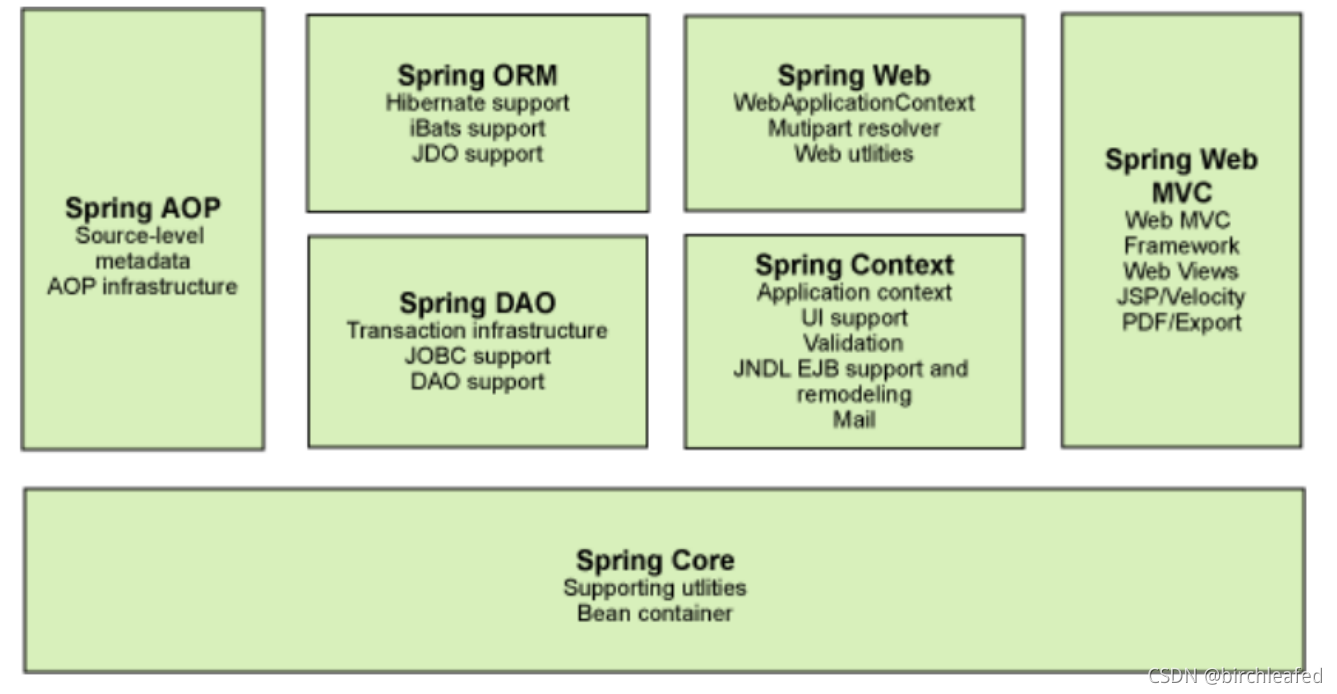
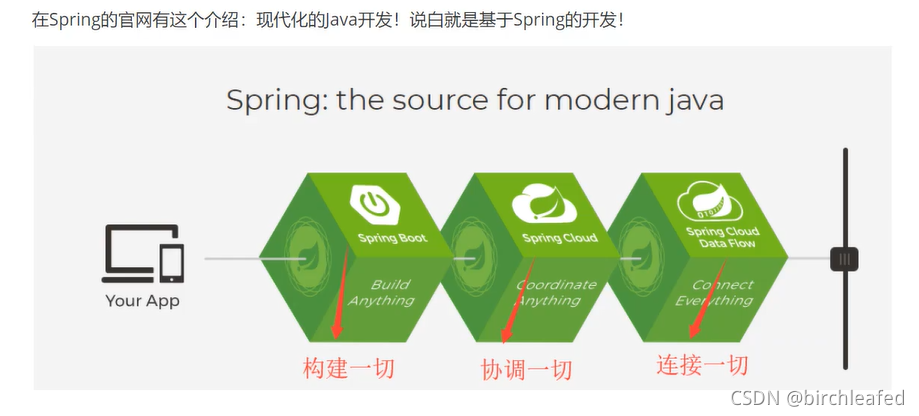
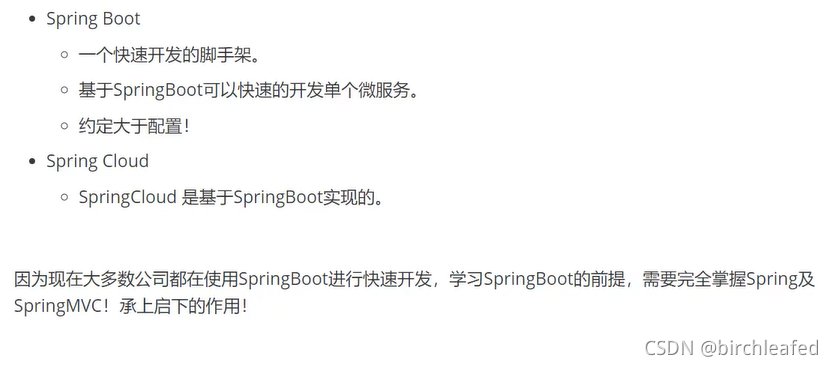
IOC理论推导
1.UserDao接口
2.UserDaoImpl实现
3.UserService业务接口
4.UserServiceImpl业务实现类
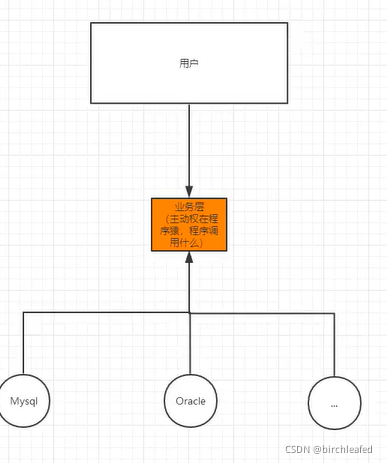
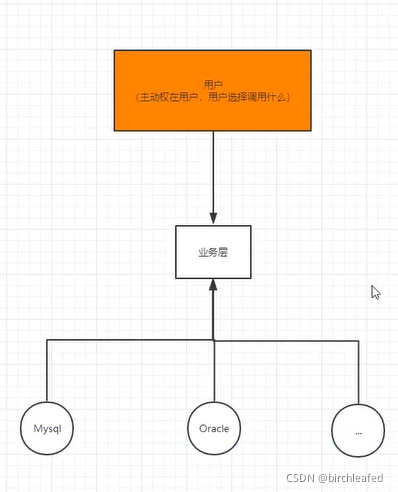
private UserDao userDao ;
public void setUserDao(UserDao userDao){
this.userDao = userDao;
}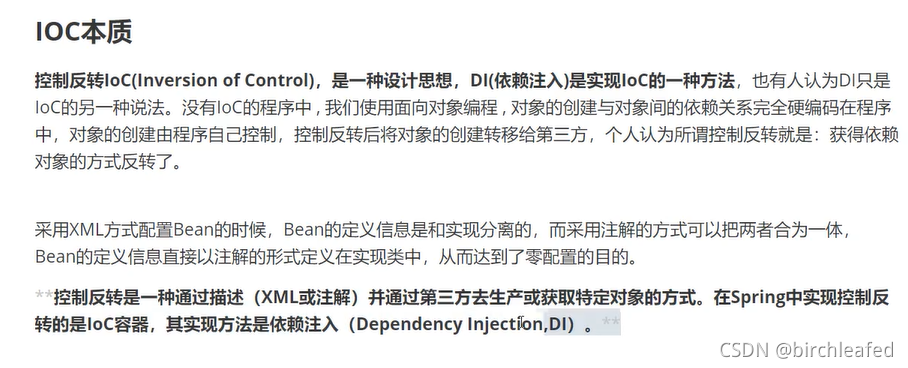
HelloSpring
package com.qi.entity;
public class Hello {
private String str;
public String getStr() {
return str;
}
public void setStr(String str) {
this.str = str;
}
@Override
public String toString() {
return "Hello{" +
"str='" + str + '\'' +
'}';
}
}
<?xml version="1.0" encoding="UTF-8"?>
<beans xmlns="http://www.springframework.org/schema/beans"
xmlns:xsi="http://www.w3.org/2001/XMLSchema-instance"
xsi:schemaLocation="http://www.springframework.org/schema/beans
https://www.springframework.org/schema/beans/spring-beans.xsd">
<!-- 使用Spring创建对象,在Spring这些都称为Bean
类型 变量名 = new 类型()
bean==对象 new Hello()
id = 变量名
class = new的对象
property相当于给对象中的属性设置一个值
-->
<bean id="hello" class="com.qi.entity.Hello">
<property name="str" value="Spring"/>
</bean>
</beans>import com.qi.entity.Hello;
import org.springframework.context.ApplicationContext;
import org.springframework.context.support.ClassPathXmlApplicationContext;
public class MyTest {
public static void main(String[] args) {
//获取Spring的上下文对象
ApplicationContext context = new ClassPathXmlApplicationContext("beans.xml");
//我们的对象都在Spring中管理,使用,直接取出来
Hello hello = (Hello) context.getBean("hello");
System.out.println(hello.toString());
}
}
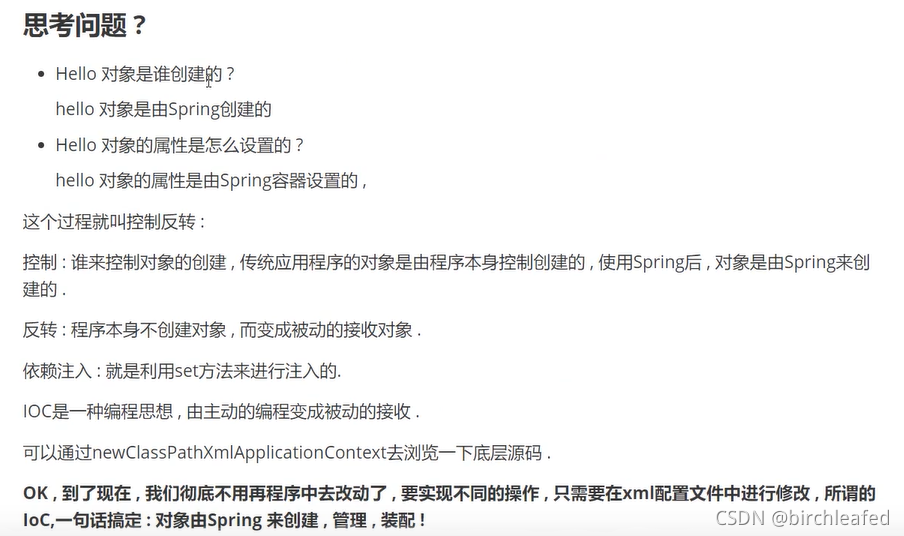
4IOC创建对象的方式
1.默认的无参构建对象
2假设我们要使用有参构造创建对象
1.下标创建
<!-- 下标赋值-->
<bean id="user" class="com.qi.entity.User">
<constructor-arg index="0" value="多久啊的空间"/>
</bean>2类型创建
<!-- 不建议使用 类型创建-->
<bean class="com.qi.entity.User" id="user">
<constructor-arg type="java.lang.String" value="按客户的骄傲看到"/>
</bean>
3按名字创建
<!-- 根据名称赋值-->
<bean id="user" class="com.qi.entity.User">
<constructor-arg name="name" value="适当"/>
</bean>
总结:在配置文件加载的时候,容器中管理的对象就已经初始化了!
5Spring配置
别名
<!-- 别名,-->
<alias name="user" alias="userNew"/>bean配置
<!--
id: bean的唯一标识符,相当于我们的对象名
class:bean对象的全限定名:包名+类型
name:也是别名,name可以同时取多个别名
-->
<bean id="userT" class="com.qi.entity.UserT" name="t e,r;f">
<property name="name" value="安康的好看"/>
</bean>
import
这个一般团队开发,将多个配置导入同一个项目当中。可以使用import将所有人的beans。xml合并到同一个项目中。
6.依赖注入
1构造器注入
前面已经说过
2.Set方式注入
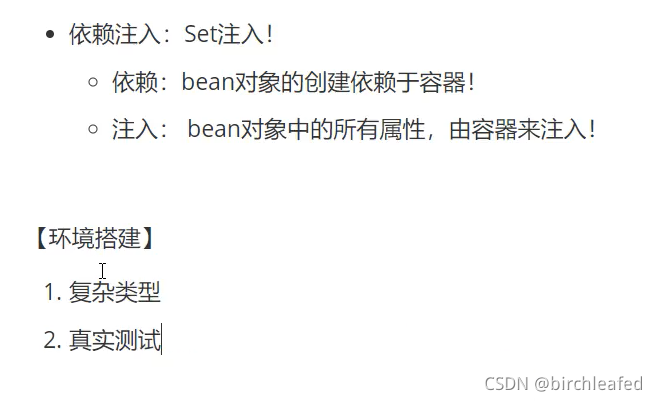
package com.qi.entity;
//复杂类型
public class Address {
private String address;
public String getAddress() {
return address;
}
public void setAddress(String address) {
this.address = address;
}
}
package com.qi.entity;
import java.util.*;
//真实类型
public class Student {
private String name;
private Address address;
private String[] books;
private List<String> hobbys;
private Map<String,String> card;
private Set<String> games;
private String wife;
private Properties info;
public String getName() {
return name;
}
public void setName(String name) {
this.name = name;
}
public Address getAddress() {
return address;
}
public void setAddress(Address address) {
this.address = address;
}
public String[] getBooks() {
return books;
}
public void setBooks(String[] books) {
this.books = books;
}
public List<String> getHobbys() {
return hobbys;
}
public void setHobbys(List<String> hobbys) {
this.hobbys = hobbys;
}
public Map<String, String> getCard() {
return card;
}
public void setCard(Map<String, String> card) {
this.card = card;
}
public Set<String> getGames() {
return games;
}
public void setGames(Set<String> games) {
this.games = games;
}
public String getWife() {
return wife;
}
public void setWife(String wife) {
this.wife = wife;
}
public Properties getInfo() {
return info;
}
public void setInfo(Properties info) {
this.info = info;
}
@Override
public String toString() {
return "Student{" +
"name='" + name + '\'' +
", address=" + address +
", books=" + Arrays.toString(books) +
", hobbys=" + hobbys +
", card=" + card +
", games=" + games +
", wife='" + wife + '\'' +
", info=" + info +
'}';
}
}
beans.xml
<?xml version="1.0" encoding="UTF-8"?>
<beans xmlns="http://www.springframework.org/schema/beans"
xmlns:xsi="http://www.w3.org/2001/XMLSchema-instance"
xsi:schemaLocation="http://www.springframework.org/schema/beans
https://www.springframework.org/schema/beans/spring-beans.xsd">
<bean id="student" class="com.qi.entity.Student">
<!-- 第一种,普通值注入-->
<property name="name" value="杜淇"/>
</bean>
</beans>测试类
import com.qi.entity.Student;
import org.springframework.context.ApplicationContext;
import org.springframework.context.support.ClassPathXmlApplicationContext;
public class Mytest {
public static void main(String[] args) {
ApplicationContext context = new ClassPathXmlApplicationContext("beans.xml");
Student student = (Student) context.getBean("student");
System.out.println(student.getName());
}
}
完善注入信息
<?xml version="1.0" encoding="UTF-8"?>
<beans xmlns="http://www.springframework.org/schema/beans"
xmlns:xsi="http://www.w3.org/2001/XMLSchema-instance"
xsi:schemaLocation="http://www.springframework.org/schema/beans
https://www.springframework.org/schema/beans/spring-beans.xsd">
<!--创建address类-->
<bean id="address" class="com.qi.entity.Address">
<property name="address" value="湖北武汉"/>
</bean>
<bean id="student" class="com.qi.entity.Student">
<!-- 第一种,普通值注入-->
<property name="name" value="杜淇"/>
<!-- 第二种,bean注入 ref-->
<property name="address" ref="address"/>
<!-- 第三种,数组注入 -->
<property name="books">
<array>
<value>西游记</value>
<value>红楼梦</value>
<value>水浒传</value>
<value>三国演义</value>
</array>
</property>
<!-- 第四种,List注入 -->
<property name="hobbys">
<list>
<value>看电影</value>
<value>吃东西</value>
<value>搞学习</value>
</list>
</property>
<!-- 第五种,Map注入 -->
<property name="card">
<map>
<entry key="身份证" value="232333"/>
<entry key="银行卡" value="43382378238"/>
</map>
</property>
<!-- 第六种,Set注入 -->
<property name="games">
<set>
<value>LoL</value>
<value>CF</value>
<value>DNF</value>
<value>PUBG</value>
</set>
</property>
<!-- 第七种,Null注入 -->
<property name="wife">
<null></null>
</property>
<!-- 第⑧种,Properties注入 -->
<property name="info">
<props>
<prop key="学号">202120383</prop>
<prop key="性别">男</prop>
<prop key="姓名">小明</prop>
</props>
</property>
</bean>
</beans>3.拓展方式注入
c与p命名:
<beans xmlns="http://www.springframework.org/schema/beans"
xmlns:xsi="http://www.w3.org/2001/XMLSchema-instance"
xmlns:p="http://www.springframework.org/schema/p"
xsi:schemaLocation="http://www.springframework.org/schema/beans
https://www.springframework.org/schema/beans/spring-beans.xsd">
<bean name="classic" class="com.example.ExampleBean">
<property name="email" value="someone@somewhere.com"/>
</bean>
<bean name="p-namespace" class="com.example.ExampleBean"
p:email="someone@somewhere.com"/>
</beans>使用
<?xml version="1.0" encoding="UTF-8"?>
<beans xmlns="http://www.springframework.org/schema/beans"
xmlns:xsi="http://www.w3.org/2001/XMLSchema-instance"
xmlns:p="http://www.springframework.org/schema/p"
xmlns:c="http://www.springframework.org/schema/c"
xsi:schemaLocation="http://www.springframework.org/schema/beans
https://www.springframework.org/schema/beans/spring-beans.xsd">
<!-- p命名空间注入可以直接注入属性的值,property-->
<bean id="user" class="com.qi.entity.User" p:name="的意思" p:age="23"/>
<bean id="user2" class="com.qi.entity.User" c:age="13" c:name="都好好的"/>
</beans>测试
@Test
public void test2(){
ApplicationContext context = new ClassPathXmlApplicationContext("userbeans.xml");
User user = (User) context.getBean("user2");
System.out.println(user);
}
Bean 的作用域
| Scope | Description |
|---|---|
| (Default) Scopes a single bean definition to a single object instance for each Spring IoC container. | |
| Scopes a single bean definition to any number of object instances. | |
| Scopes a single bean definition to the lifecycle of a single HTTP request. That is, each HTTP request has its own instance of a bean created off the back of a single bean definition. Only valid in the context of a web-aware Spring | |
| Scopes a single bean definition to the lifecycle of an HTTP | |
| Scopes a single bean definition to the lifecycle of a | |
| Scopes a single bean definition to the lifecycle of a |
1代理模式默认机制
<bean id="user2" class="com.qi.entity.User" c:age="13" c:name="都好好的" scope="singleton"/>
2原型模式:每次从容器中get 都产生新对象
<bean id="user2" class="com.qi.entity.User" c:age="13" c:name="都好好的" scope="prototype"/>
3其余的request Session application 在web开发中使用
Bean的自动装配
自动装配是Spring满足bean依赖的一种方式
spring会在上下文中自动寻找,并自动给bean装配属性
spring 中有三种装配方式
1在xml中显示的装配
2在Java中显示的装配
3隐式的自动装配bean【重要】
测试spring的自动装配
环境搭建:一个人有两个宠物
ByName自动装配
<bean id="cat" class="com.qi.entity.Cat"/>
<bean id="dog" class="com.qi.entity.Dog"/>
<!--
byName 会自动在容器上下文中查找,和自己对象set方法后面值对应的beanid
byType 会自动在容器上下文中查找,和自己对象属性类型相同的bean
-->
<bean id="people" class="com.qi.entity.People" autowire="byName">
<property name="name" value="杜淇"/>
</bean>ByType
<bean id="cat" class="com.qi.entity.Cat"/>
<bean id="dog" class="com.qi.entity.Dog"/>
<!--
byName 会自动在容器上下文中查找,和自己对象set方法后面值对应的beanid
byType 会自动在容器上下文中查找,和自己对象属性类型相同的bean
-->
<bean id="people" class="com.qi.entity.People" autowire="byType">
<property name="name" value="杜淇"/>
</bean>
使用注解进行自动装配

<?xml version="1.0" encoding="UTF-8"?>
<beans xmlns="http://www.springframework.org/schema/beans"
xmlns:xsi="http://www.w3.org/2001/XMLSchema-instance"
xmlns:context="http://www.springframework.org/schema/context"
xsi:schemaLocation="http://www.springframework.org/schema/beans
https://www.springframework.org/schema/beans/spring-beans.xsd
http://www.springframework.org/schema/context
https://www.springframework.org/schema/context/spring-context.xsd">
<context:annotation-config/>
</beans>@Autowired
直接在属性上使用即可,也可以在set方式上使用
使用Autowired我们可以不用编写Set方法,前提是自动装配的属性在IOC(spring)容器中存在,且符合名字byname
//如果显示的定义了Autowired的required的属性为false,说明这个对象可以为null,否则不允许为空
@Autowired(required = false)
private Cat cat;
@Autowired
@Qualifier(value = "dog222")
private Dog dog;
private String name;
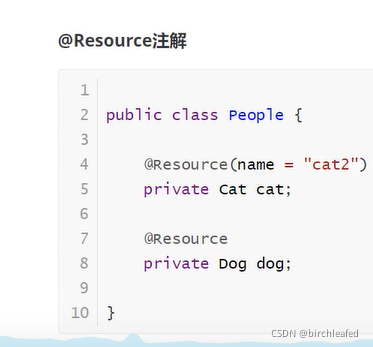

使用注解开发
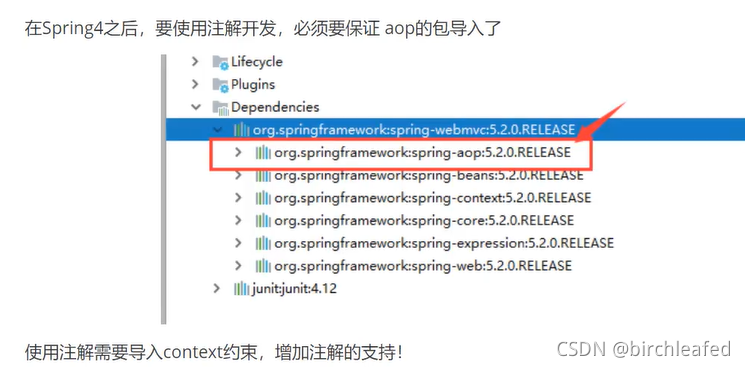
<?xml version="1.0" encoding="UTF-8"?>
<beans xmlns="http://www.springframework.org/schema/beans"
xmlns:xsi="http://www.w3.org/2001/XMLSchema-instance"
xmlns:context="http://www.springframework.org/schema/context"
xsi:schemaLocation="http://www.springframework.org/schema/beans
https://www.springframework.org/schema/beans/spring-beans.xsd
http://www.springframework.org/schema/context
https://www.springframework.org/schema/context/spring-context.xsd">
<context:annotation-config/>
</beans>1bean
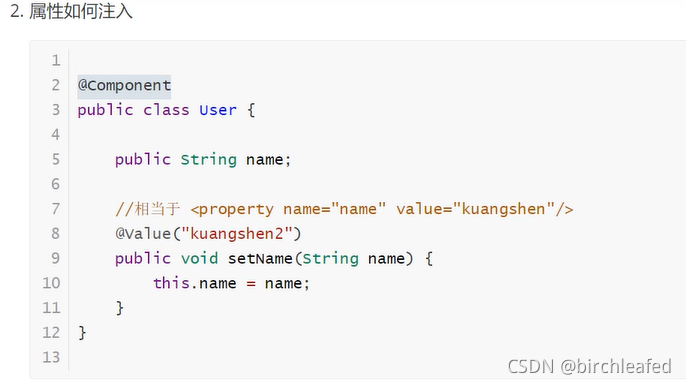


5作用域
//等价于<bean id = "user" class="com.qi.entity.User"/>
//@Component 等价于组件
@Component
@Scope("prototype")
public class User {
public String name ;
//相当于<property name="name" value="duqi"/>
@Value("duqi")
public void setName(String name) {
this.name = name;
}
}6.小结
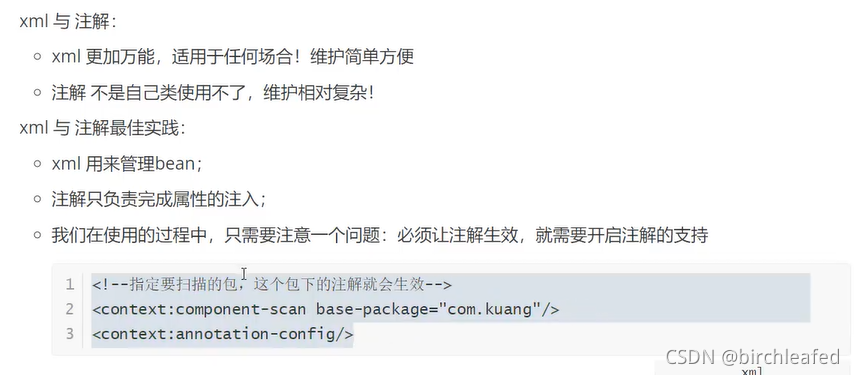 使用Java的方式配置Spring
使用Java的方式配置Spring

实体类
package com.qi.entity;
import org.springframework.beans.factory.annotation.Value;
import org.springframework.stereotype.Component;
//这个注解说明这个类被Spring接管了,注册到了容器当中
@Component
public class User {
private String name;
public String getName() {
return name;
}
@Value("dyuayd")
public void setName(String name) {
this.name = name;
}
@Override
public String toString() {
return "User{" +
"name='" + name + '\'' +
'}';
}
}
配置类
package com.qi.config;
import com.qi.entity.User;
import org.springframework.context.annotation.Bean;
import org.springframework.context.annotation.ComponentScan;
import org.springframework.context.annotation.Configuration;
import org.springframework.context.annotation.Import;
//也会被Spring接管本来就是@Component
//代表这是一个配置类与我们之前看到的beans.xml是相同的
@Configuration
@ComponentScan("com.qi.entity")
@Import(MyConfig2.class)
public class MyConfig {
//注册一个bean 相当于我们之前写的一个bean标签
//这个方法的名字就相当于bean标签中的id属性
//这个方法的返回值就相当于bean标签的class属性
@Bean
public User getUser(){
return new User();//就是返回要注入到bean的对象
}
}
测试类
import com.qi.config.MyConfig;
import com.qi.entity.User;
import org.springframework.context.ApplicationContext;
import org.springframework.context.annotation.AnnotationConfigApplicationContext;
public class MyTest {
public static void main(String[] args) {
//如果完全使用配置类方式去做,我们就只能通过AnnotationConfigApplicationContext上下文来获取容器,通过配置类的class对象加载
ApplicationContext context = new AnnotationConfigApplicationContext(MyConfig.class);
User getUser = (User) context.getBean("getUser");
System.out.println(getUser.getName());
}
}
AOP代理模式
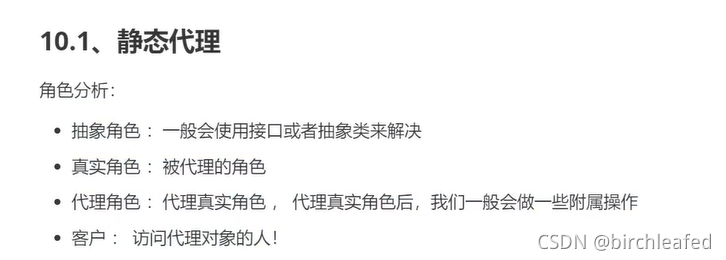
代码步骤
1接口
package com.qi.demo01;
public interface Rent {
public void rent();
}
2真实角色
package com.qi.demo01;
public class Host implements Rent{
public void rent(){
System.out.println("房东租房子");
}
}
3代理角色
package com.qi.demo01;
public class Proxy implements Rent{
private Host host;
public Proxy(){
}
public Proxy(Host host){
this.host = host;
}
public void rent(){
seeHouse();
host.rent();
fare();
hetong();
}
public void seeHouse(){
System.out.println("中介看房");
}
public void fare(){
System.out.println("中介费");
}
public void hetong(){
System.out.println("签合同");
}
}
4客服端访问代理角色
package com.qi.demo01;
public class Client {
public static void main(String[] args) {
Host host = new Host();
Proxy proxy = new Proxy(host);
proxy.rent();
}
}


动态代理
底层均为反射
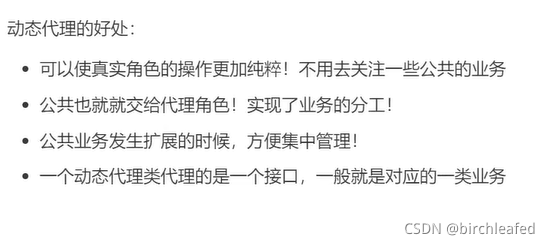
package com.qi.demo04;
import com.qi.demo03.Rent;
import java.lang.reflect.InvocationHandler;
import java.lang.reflect.Method;
import java.lang.reflect.Proxy;
public class ProxyInvocationHandler implements InvocationHandler {
//被代理的接口
private Object target;
public void setTarget(Object target) {
this.target = target;
}
//生成得到代理类
public Object getProxy(){
return Proxy.newProxyInstance(this.getClass().getClassLoader(), target.getClass().getInterfaces(),this);
}
//处理代理实例,并返回结果
@Override
public Object invoke(Object proxy, Method method, Object[] args) throws Throwable {
//动态代理的本质就是使用反射机制实现
log(method.getName());
Object result = method.invoke(target, args);
return result;
}
public void log(String msg){
System.out.println("执行了" + msg + "方法");
}
}
package com.qi.demo04;
import com.qi.demo02.UserService;
import com.qi.demo02.UserServiceImpl;
public class Client {
public static void main(String[] args) {
//真实角色
UserServiceImpl userService = new UserServiceImpl();
//代理角色,不存在
ProxyInvocationHandler proxyInvocationHandler = new ProxyInvocationHandler();
proxyInvocationHandler.setTarget(userService);//设置要代理的对象
//动态生成代理类
UserService proxy = (UserService) proxyInvocationHandler.getProxy();
proxy.add();
}
}
AOP

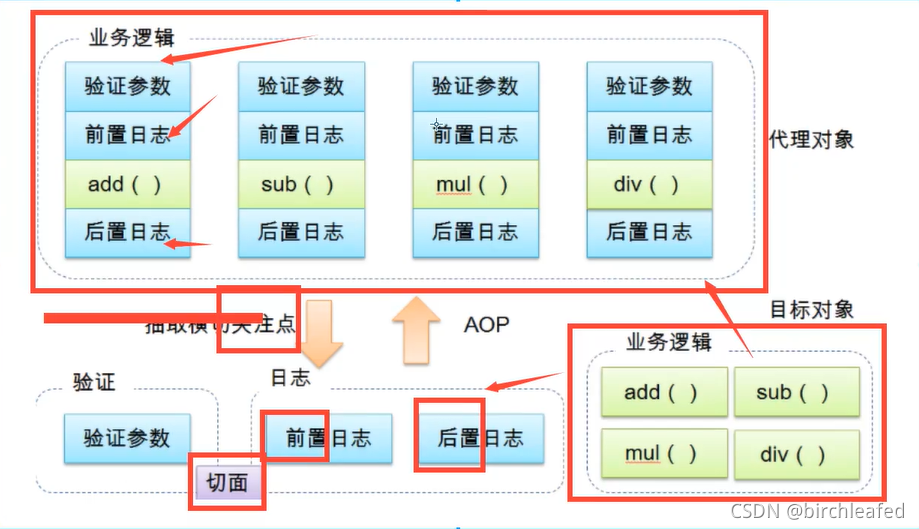
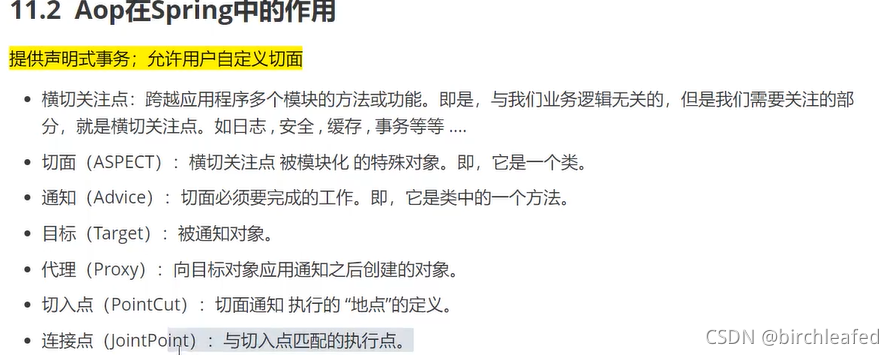
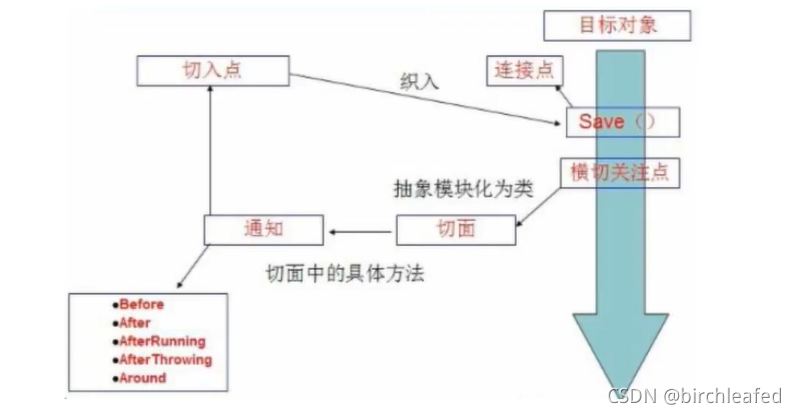
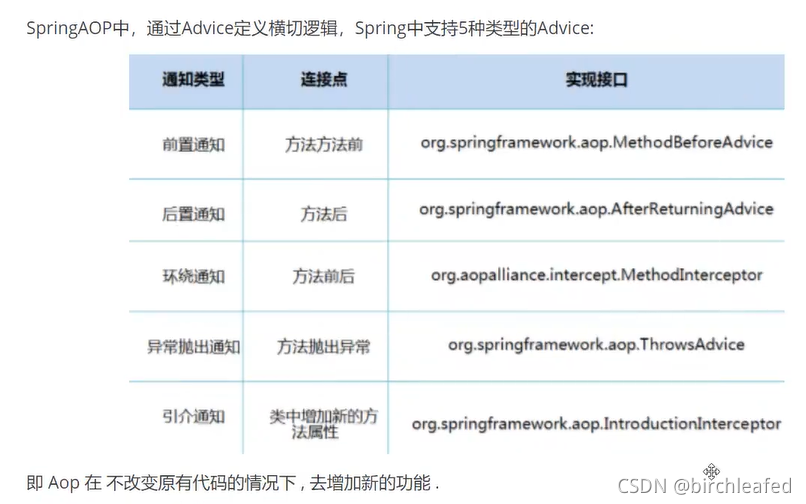

<dependency>
<groupId>org.aspectj</groupId>
<artifactId>aspectjweaver</artifactId>
<version>1.9.4</version>
</dependency>方式一,使用Spring 的API接口【主要SpringAPI接口实现】
方式二 自定义实现AOP【主要是切面定义】
方式三 使用注解方式实现
整合MyBatis
1.导入相关jar包
·junit
mybatis
mysql
spring
aop织入
2编写配置文件
<?xml version="1.0" encoding="UTF-8"?>
<project xmlns="http://maven.apache.org/POM/4.0.0"
xmlns:xsi="http://www.w3.org/2001/XMLSchema-instance"
xsi:schemaLocation="http://maven.apache.org/POM/4.0.0 http://maven.apache.org/xsd/maven-4.0.0.xsd">
<parent>
<artifactId>spring-study</artifactId>
<groupId>org.example</groupId>
<version>1.0-SNAPSHOT</version>
</parent>
<modelVersion>4.0.0</modelVersion>
<artifactId>spring-10-mybatis</artifactId>
<properties>
<maven.compiler.source>8</maven.compiler.source>
<maven.compiler.target>8</maven.compiler.target>
</properties>
<dependencies>
<dependency>
<groupId>junit</groupId>
<artifactId>junit</artifactId>
<version>4.11</version>
</dependency>
<dependency>
<groupId>mysql</groupId>
<artifactId>mysql-connector-java</artifactId>
<version>5.1.47</version>
</dependency>
<dependency>
<groupId>org.mybatis</groupId>
<artifactId>mybatis</artifactId>
<version>3.5.2</version>
</dependency>
<dependency>
<groupId>org.springframework</groupId>
<artifactId>spring-webmvc</artifactId>
<version>5.3.9</version>
</dependency>
<!-- spring链接数据库的话还需要一个spring-jdbc 的包-->
<dependency>
<groupId>org.springframework</groupId>
<artifactId>spring-jdbc</artifactId>
<version>5.3.10</version>
</dependency>
<dependency>
<groupId>org.aspectj</groupId>
<artifactId>aspectjweaver</artifactId>
<version>1.9.4</version>
</dependency>
<dependency>
<groupId>org.mybatis</groupId>
<artifactId>mybatis-spring</artifactId>
<version>2.0.2</version>
</dependency>
</dependencies>
</project>3测试
回忆mybatis
1.编写实体类
2.编写核心配置文件
3.编写接口
4.编写xml
5.测试
整合Mybatis-spring
1.编写数据源配置
2.sqlSessionFactory
3.sqlSessionTemplate
4.需要给接口加实现类
5.将自己写的实现类,注入到Spring中
6.测试使用即可
声明式事务
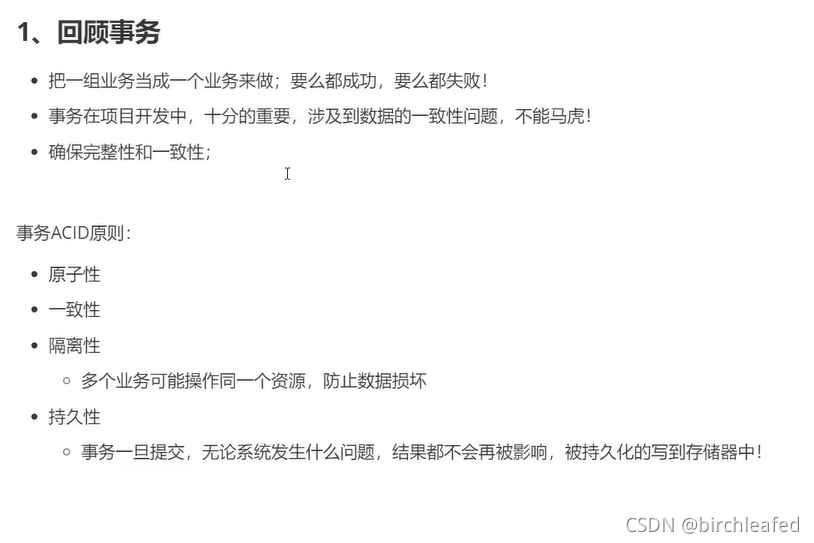





 本文详细介绍了Spring框架的控制反转和面向切面编程特性,包括Maven包引用、优点、模块划分、IOC应用实例和配置详解,以及AOP代理模式、自动装配和Spring与MyBatis整合等内容。
本文详细介绍了Spring框架的控制反转和面向切面编程特性,包括Maven包引用、优点、模块划分、IOC应用实例和配置详解,以及AOP代理模式、自动装配和Spring与MyBatis整合等内容。
















 6972
6972

 被折叠的 条评论
为什么被折叠?
被折叠的 条评论
为什么被折叠?








